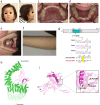Characteristic craniofacial defects associated with a novel USP9X truncation mutation
- PMID: 38755172
- PMCID: PMC11099082
- DOI: 10.1038/s41439-024-00277-w
Characteristic craniofacial defects associated with a novel USP9X truncation mutation
Abstract
Germline loss-of-function mutations in USP9X have been reported to cause a wide spectrum of congenital anomalies. Here, we report a Japanese girl with a novel heterozygous nonsense mutation in USP9X who exhibited intellectual disability with characteristic craniofacial abnormalities, including hypotelorism, brachycephaly, hypodontia, micrognathia, severe dental crowding, and an isolated submucous cleft palate. Our findings provide further evidence that disruptions in USP9X contribute to a broad range of congenital craniofacial abnormalities.
© 2024. The Author(s).
Conflict of interest statement
The authors declare no competing interests.
Figures


References
LinkOut - more resources
Full Text Sources

